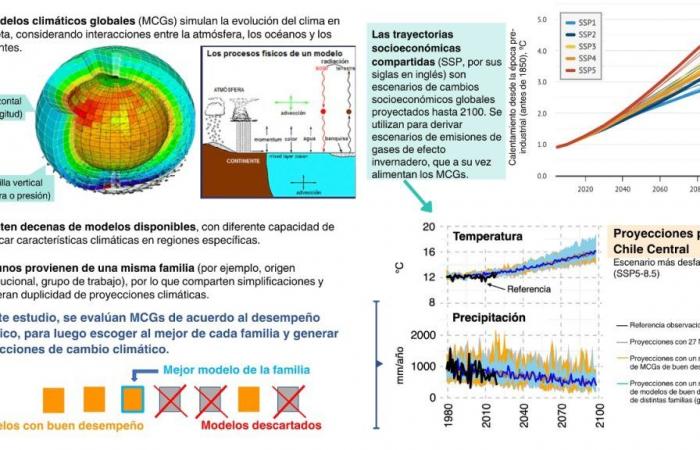Research led by the Department of Civil Engineering (DIC) and the Advanced Mining Technology Center (AMTC) of the University of Chile, with the support of the consulting firm ERIDANUS, presents a model evaluation strategy to estimate possible changes in Precipitation and temperature in macrozones of Chile towards the end of the 21st century. The methodology can be used in any region of the world, allowing the identification of models with better performance.
The global climate models (GCMs) They are tools that allow us to simulate the evolution of the Earth’s climate system, including the dynamics of the atmosphere and its interaction with the oceans and continents. To do this, these models require stimuli or forcing that can be of natural origin (such as changes in the Earth’s orbit or in solar luminosity and volcanic eruptions) or anthropogenic (for example, emission of polluting gases). Within this last group, greenhouse gases stand out and, in particular, carbon dioxide, whose concentration in the atmosphere has increased dramatically in recent decades, causing an increase in global temperature and, with it, changes in the climatic characteristics of different regions of the planet.
Currently, Climate models are widely used to project the evolution of climate variables for the coming decades under different socioeconomic development scenarios. However, there are dozens of climate models available – some of which copy aspects of others – and considering them all for local-level impact studies remains computationally very expensive. Furthermore, GCMs do not necessarily replicate historical characteristics that are relevant for the analysis of impacts on, for example, future water availability or the occurrence of extreme hydrometeorological events.
To address these problems, a group of researchers from the Faculty of Physical and Mathematical Sciences of the University of Chile designed a methodology to evaluate climate models based on their ability to replicate climate characteristics and the possible similarity with projections generated by other models, achieving climate projections for an unfavorable emissions scenario.
The study, published in the journal Climatic Change, evaluates 27 climate models from the sixth phase of the Coupled Model Comparison Project (CMIP6) in five climatic macrozones that cover all of continental Chile. The evaluation considered the ability to reproduce historically observed patterns in precipitation and surface air temperature (such as annual averages, seasonality), in addition to its connection with climatic and oceanic oscillations that operate at large scales (a concept known as teleconnection), allowing us to rule out unrealistic models.
“The methodology is flexible enough to adapt it depending on the objectives of the study. For example, if you are interested in analyzing the possible effects of climate change on the frequency and magnitude of floods, you can include indicators aimed at this and weight their importance differently,” he explains. Felipe Gateño, civil engineer at the University of Chile and lead author of the study.
“The study addresses an issue that has been relevant to the global community for decades,” he says. Pablo Mendoza, hydrologist and academic at the Department of Civil Engineering of the University of Chile. “We know that an important fraction of the uncertainty in hydroclimatic projections comes from the choice of climate models, so their evaluation is a key step to understand their limitations and choose them based on their potential for specific applications. This is especially important in the construction of civil works and in management plans for our water resources, whose design requires considering potential effects of climate change.”, he maintains.
The authors used the resulting scheme to generate projections under an economic development scenario highly dependent on fossil fuels. “The results show a high degree of agreement between the selected models in relation to future warming in all macrozones, and a signal of drying for April-July in central and southern Chile. The chosen models project a 37% reduction in annual precipitation in Central Chile, and the most severe warming in the Norte Grande, with an increase in temperature of 3.7°C, and an increase of 3.6°C in the temperature of the Norte Chico“, points out Nicolás Vásquez, co-author of the study.
“Regional models often use climate models selected or evaluated at a continental scale, but which do not necessarily represent characteristics of interest at smaller scales,” he indicates. Miguel Lagos-Zúñiga, hydrometeorologist and co-author of the study. “The methodological proposal is applicable to any part of the planet and, in particular, to continental Chile, which will help strengthen projections of the effects of climate change not only for CMIP6 models, but also for future phases of the CMIP initiative” , he points out.
The research team was made up of Felipe Gateño (DIC/Eridanus), Pablo Mendoza (DIC/AMTC), Nicolás Vásquez (DIC), Miguel Lagos-Zúñiga (AMTC, CR2 and Department of Civil Works, USM), Héctor Jiménez (AMTC ), Catalina Jerez (AMTC), Ximena Vargas (DIC), Eduardo Rubio-Álvarez (Eridanus) and Santiago Montserrat (AMTC), and is part of the Fondecyt project “Robust estimates of current and future water resources across a hydroclimatic gradient in Chile ”, directed by Professor Pablo Mendoza.



